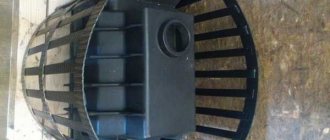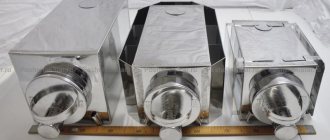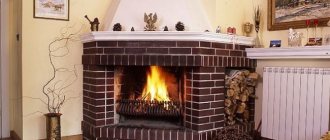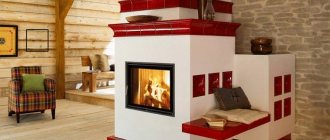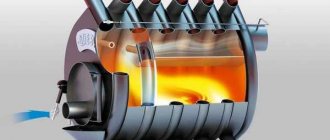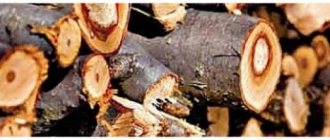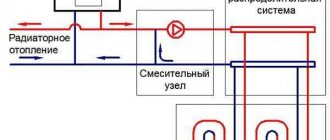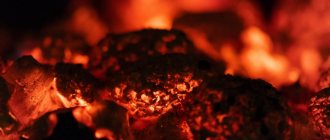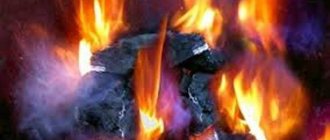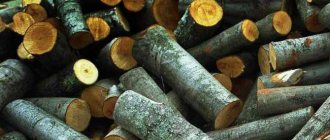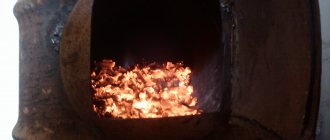For a city dweller, inexperienced with rural experience, who spends most of his adult life in an apartment in a multi-storey building, heating a bathhouse is not easy. But this is at first, due to lack of experience and practical skills. If you are new to the bath business and you, a seasoned bath master, have been instructed to light the stove and warm up the bath thoroughly, be sure to read this article. It will definitely come in handy.
Choosing firewood
Firewood and a stove are the pillars on which a good bathhouse stands. And, if an unusable stove can only be broken in order to be rebuilt, then unusable firewood can always be replaced. What kind of firewood should you avoid?
We don't need that kind of firewood.
“Yes, we don’t need this kind of hockey!” exclaimed legendary sports commentator Nikolai Ozerov, when Canadian professionals frantically began beating Soviet amateurs. Any self-respecting stoker has the right to say exactly the same phrase when he sees such firewood, before lighting the bathhouse:
- Railway sleepers. When dismantling and repairing railway tracks, a lot of free firewood often appears, which, greedy for free compatriots, happily drag to their native lands. Sleepers, poles and other elements of the industrial landscape are treated with protective compounds that prevent them from rotting. Burning them in a furnace leads to the sublimation of such substances and their combustion products into the internal atmosphere of the steam room, which is very fraught. Even deaths were recorded;
- Boards with traces of paintwork. The reason is the same;
- Wood with signs of destruction by fungi, the so-called rotten wood. In this case, you won’t be able to swallow chemical filth, but there will be little benefit from burning such raw materials. Wood that has been subjected to destruction by fungi and parasites greatly loses its caloric content and it is better to use suitable firewood than to heat the stove with dust, even if it is free.
What we look at with apprehension and distrust
Due to a number of features, the following types of wood are not entirely suitable:
- Spruce is a low-calorie fuel. With an equal volume of burned raw materials, less heat is released. Due to the high resin content, a large amount of soot is released during combustion;
- Pine - gives a high, light, but low-temperature flame. They burn out quickly and do not retain heat well. Tendency to shoot coals, which requires increased attention to avoid fire in the furnace flue space. To a lesser extent, but also clogs chimneys with soot and tar deposits;
- Poplar and aspen are lightweight firewood that produces a long flame that burns well through chimneys, but is low in calories and does not retain heat well. When constantly used to fire a stove, conifer wood must be used to clean chimneys naturally, using the power of flame.
What we need
This includes firewood of the highest quality category. It is with these that it is most pleasant to decide how to properly flood a bathhouse:
- Alder is “royal” firewood. Produces a dense, clean, consistent flame. Fully high-calorie wood, quite acceptable in terms of labor costs for manual firewood harvesting;
- Oak and ash are very valuable woods that, when burned, give off a characteristic and unique spicy aroma. High-calorie firewood that retains heat perfectly. They burn long enough and evenly. Oak splits perfectly along the grain, producing dies of standard size. They are expensive due to the value of the wood. It is possible to use wood processing waste;
- Birch is probably the best option for solving the question of how to heat a bathhouse. They provide high-calorie and high-quality fuel raw materials. When using woodworking waste, birch bark should be used with caution, due to the increased release of volatile resins deposited on the walls of chimneys. With relative cheapness and accessibility, a true classic of the genre in the making;
- Fruit firewood - like any other hardwood, produces high-quality firewood, distinguished, among other things, by a subtle spicy aroma when burned. Quite expensive. In addition, some tree species are highly durable and knotty, which makes harvesting firewood in significant volumes quite a fun process in all respects.
How to properly heat a sauna with a metal stove?
Owners of such heating devices should remember the main advice - to lay logs often, but little by little. Otherwise, you will cause the oven to overheat, after which it will take a long time to cool down.
Distinctive features of the iron stove:
- It warms up quickly. Such settings reach optimal mode within 20 minutes after igniting the wood.
- Heating of the room begins as soon as the device itself warms up.
- An iron stove requires more fuel. Firewood or briquettes burn much faster than in a classic brick heater.
- Such stoves do not always maintain the same temperature in the chimney and combustion chamber.
A metal heater can be supplemented with a brick shield. Some lovers of Russian baths do just that - they line the appliances with bricks, thus increasing the time of heat release.
The technology for lighting a metal stove includes the following steps:
- Place some paper on the bottom of the firebox.
- Place the logs on the paper (not too tightly).
- Fill the combustion chamber two-thirds full.
- Light the paper with a match.
- Add new logs only after the previous ones have completely burned out.
Avoid the following common mistakes:
- excess firewood overflowing the combustion chamber,
- excessively dense arrangement of logs,
- closing the stove vent too early.
It should also be remembered that the flame in such a heater should not be too strong. It is much better when the firewood smolderes slowly, releasing heat evenly into the room.
Let's give the country coal
The use of coal for heating a bathhouse is a very delicate, if not scrupulous, issue. On the one hand, coal, especially high-quality anthracite, is a very high-calorie fuel that maintains the temperature inside the coal cake for a long time. In addition, anthracite and semi-anthracite produce relatively few volatile substances during combustion; they form soot plugs in chimneys.
On the other hand, truly high-quality anthracite is not always available and is almost always not cheap. Ordinary gas coals are prone to the formation of flue gases saturated with solid soot particles, which radically pollute smoke exhaust systems.
And finally, the combustion of coal is associated with the formation of a large amount of ash, which requires disposal, and the combustion process itself is accompanied by the characteristic and unpleasant smell of coal tar. In general, coal cannot be classified as an environmentally friendly fuel and therefore, when solving the problem of what is the best way to heat a bathhouse, coal should be considered last.
The dilemma of how to properly heat a bathhouse with a metal stove with coal is in most cases solved in budget establishments that provide bathing services on a commercial basis. Due to their specificity, heating with wood, and of high quality, is quite a costly undertaking, sometimes eating up all the profit.
How to heat a sauna
Heating a sauna is an art. You need to know its subtleties: how to properly add firewood, what material to use, to what temperature it needs to be heated.
The ideal, safe and profitable fuel is firewood.
Before taking bath procedures, you need to prepare it. Be sure to fill the boiler with water first.
First you need to put things in order. Wash floors, ceilings and all shelves using antiseptic agents. Ventilate the room well.
Preparation takes place in several stages:
Lords of Stone and Fire
Now it’s worth considering the algorithm for the problem of how to properly heat a stove. In general, the entire process can be divided into several main stages, such as: preparation, combustion and completion of combustion. Previously, any housewife knew thoroughly how to heat a Russian stove and, most importantly, how to properly heat a Russian stove. And a complex sauna stove is in many ways similar to a Russian house stove. And for such a housewife, the problem of how to flood the bathhouse is not a problem at all. There would be firewood. Well, we’ll start with the ABCs, with the very basics.
On your marks
At the preparatory stage it is necessary:
- Conduct an external inspection of the stove, ducts and chimneys to ensure there are no visible damages or malfunctions.
- Check traction. To do this, just light a crumpled sheet of paper in the firebox and watch the behavior of the flame. It should steadily deviate deeper into the firebox, towards the smoke channel. It is also useful to cover the ash flap and monitor how the level of natural draft drops by the behavior of the same flame.
- Remove from the pre-furnace space all flammable objects that could serve as a source of ignition near the stove as a result of inadvertent sparks.
- Clean the ash pan and grates from ash to ensure normal air circulation during the combustion process.
- If the furnace design has water boilers and jackets, check that they are at the required level to prevent them from burning out.
- Open the chimney valves and open the ash door.
- Let's check the heater insert. As is known, for normal heat transfer, the ratio of the volume of working stones in the heater in relation to the volume of the steam room should be within 1:50.
Attention! Wood ash is an excellent organic fertilizer and a source of such an important element in plant nutrition as potassium. In addition, local application of ash under fruit trees has some disinfecting properties. Naturally, the ash must be cooled. When applying on a large scale, control the acidity of the soil, since ash has a pronounced alkaline reaction.
Ignition
Now, a few words about the quality of firewood, or more precisely, about its humidity. Firewood, like gunpowder, should always be kept dry. For this purpose, even in the simplest bathhouse design, without a dressing room, a canopy was provided above the entrance for storing clothes and firewood. It is better not to know how to heat a stove with raw wood, since raw wood shoots, smokes and does not burn, or rather, it burns, but poorly. The size of the firewood matters. Logs of various sizes are needed at certain stages of heating the stove. This trend is clearly visible directly during ignition:
- We fill the firebox with seed, that is, small firewood, birch bark, wood chips, paper, which ensures reliable ignition.
- As the flame sets the seed and begins to burn confidently, we add small logs “staggered”, that is, leaving free space between them for air circulation. We make sure not to “lock” the flame in the firebox with excessive quantity or size of firewood. At the same time, it is very important not to look through the flame, to prevent the seed from completely burning out.
- At this time, the firebox door can be kept ajar for a better supply of air oxygen to the combustion site.
Important! There is a large selection of special alcohol-containing liquids for lighting barbecues on the market. The fire department strongly does not recommend using them for a colorful show like how to quickly light a stove, in order to avoid uncontrolled burning of high intensity. Consuming them internally is also not recommended, but by the Ministry of Health.
Everything is fine, we're on fire
As the seed burns out and the first load of firewood begins to burn confidently, you can perform the following actions:
- We put standard size firewood into the entire volume of the firebox, but leaving a gap of 200-250 mm to the upper arch of the firebox. Modern science has not yet figured out how to heat a stove with a firebox filled with wood right up to the vault. This rule must be observed throughout the entire process of heating the bath.
- Open the ash door. The firebox door must be tightly closed.
- We monitor the air temperature in the steam room and the water in the boiler, if the stove is equipped with one. Visually monitors the temperature and condition of the stone backfill by its appearance.
Depending on the quality of the stove, the thermal insulation properties of the bath structure and other individual conditions, the time to reach the operating air temperature of 60 degrees Celsius can take about 2-5 hours. Approximately the same algorithm of actions applies to the question of how to properly heat a bathhouse with an iron stove.
A word from Experienced! When laying firewood, follow the direction of laying the logs, which should be parallel to the long side of the firebox. In addition, a prerequisite is the need to leave a gap between the firewood and the firebox door. As a rule, 10-12 cm is enough. During combustion, control the stability and quality of draft. Clean the grates if they become clogged.
Finish of the furnace firing
Once the air temperature in the steam room reaches operating levels, the stove can be extinguished. But, as in the question of how to light a stove, there is also a certain algorithm of actions and its own nuances:
- If you are sure that further burning of the stove is inappropriate, then the addition of firewood stops;
- The stove vent is closed and the chimney damper is closed;
- At this time, in conditions of insufficient oxygen supply to the firebox, the formation of very dangerous carbon monoxide is possible - carbon monoxide, the insidiousness of which lies in its lack of color and odor.
Attention! A sign of fuel combustion under conditions of a significant lack of oxygen is the coloring of the flames yellow with a purple rim.
- Visually inspect the color of the stone backfill in the heater again;
- The bathhouse is thoroughly ventilated and steamed with the first steam.
A visual table reflecting the calorific value of various types of firewood, both dry and freshly cut, will help you learn how to heat a stove in a bathhouse correctly and effectively:
| Wood name | Specific heat of combustion, kW h/kg | Nominal combustion heat for dry firewood at 18% humidity, kWh/cub.m. | Nominal combustion heat for freshly cut firewood at 55% humidity, kWh/m3. |
| Beech | 4,2 | 2200 | 1900 |
| Oak | 4,2 | 2100 | 1850 |
| Ash | 4,2 | 2100 | 1850 |
| Birch | 4,3 | 1900 | 1670 |
| Elm | 4,1 | 1900 | 1670 |
| Maple | 4,1 | 1900 | 1670 |
| Alder | 4,1 | 1500 | 1300 |
| Poplar | 4,1 | 1400 | 1230 |
| Pine | 4,4 | 1500 | 1300 |
The secret of brick kilns
Traditionally, several types of stone stoves are used to heat baths. The more massive the stove, the more difficult the ignition process. For example, a Russian stove in a bathhouse, which is used a couple of times a month, is sometimes very difficult to light, especially if the building has been standing in the cold for a couple of weeks and is completely frozen, from the cap on the chimney to the foundation.
The easiest way to heat a sauna is with traditional Dutch ovens or fireplace stoves.
The mass of the Dutch oven is small, the wall thickness is at best half a brick. Therefore, it is enough to check the state of the draft in the pipe, and you can set fire to the wood.
Then everything is simple, two logs of wood are placed in parallel in the firebox, the driest ones that are available in the firewood supply. Wood chips are laid out on top of the logs, set on fire and the material is placed so that the lower logs warm up and begin to smolder. The rest of the firewood is loaded into the stove to capacity and waits for the first burnout.
After ¾ of the stored firewood has burned out, the firebox is loaded with a second portion, the valve is closed, and you can go steam.
Fireplace stoves are 2-2.5 times heavier than Dutch stoves; in addition, the fire in the hearth must be constantly maintained by adding a fresh portion of firewood. If the bathhouse is supposed to be heated with a fireplace, then a separate person will be required to manage the process - a stoker, whose responsibilities include managing the process of burning wood.
A fireplace stove has one advantage - very strong draft. When wood is burning in the hearth, there is a real draft in the dressing room. Therefore, to gain heat and heat in the heater, you can burn peat briquettes along with firewood. Only after the cast-iron mirror, screen and fireplace chimney have warmed up to maximum temperature, can you install a screen in front of the fireplace, close the damper and only maintain a small flame so that the draft in the chimney takes away smoke and carbon monoxide from the dressing room.
